Introduction
of different mining algorithms implementation. We shows that
it is possible to get much more information's by applying some analysis
techniques on the mining results. Another very important kind of plug-ins which
provide to ProM the ability to convert one model into another model is also
presented.
In the third chapter analyze and compare process mining
algorithms against a known ground truth, using the ProM framework. The analysis
concerns three mining algorithms, namely: the Alpha algorithm, Heuristic
algorithm and Genetic algorithm, according to the metrics presented in the
chapter 1.
Finally, in the chapter 4 we present our approach to traces
clustering with some experimentation results. Then, we conclude this thesis by
a short conclusion and some perspectives.
4
Chapter1
Business Process and Process Mining
1.1 Introduction
In this chapter we introduce the main aspects of Business
Process (BP) and Process Mining (PM) field. We present these two inherently
related field following three main sections. The first section (Section 1.2) is
devoted to the basic notions of Business Process. Indeed, we begin this section
by giving some definitions, the BP life cycle then some BP modeling languages.
In the second section (Section 1.3) we present an overview of the Process
Mining filed. Indeed, in this part we present different related aspects to the
Process Mining like: Event Logs, Log filtering and Process Mining Perspectives.
After that, we expose some notions related to the Control-Flow Discovery
algorithms. In the third section, we describe some evaluation approaches of
business processes (Section 1.4). We expose in this section different
evaluation metrics.
1.2 Business Processes
The term "business process" is often used to refer to
different concepts such as : abstract process, executable process or
collaborative process [54]. A business process is a choreography of activities
including an interaction between participants in the form of exchange of
information. Participants can be:
· Applications / Services Information System,
· Human actors,
· Other business processes.
5
Business Process and Process Mining
1.2.1 Definitions
Different definitions were given to the business process in
the literature. In [13], the authors consider that a business process is :
A collection of activities that takes one or more kinds
of input and creates an output that is of value to the customer. A business
process has a goal and is affected by events occurring in the external world or
in other processes.
A more formal definition were given by [1],
A business process P is defined as a set of activities
Vp = {V1, V2, ...Vn},
a directed graph Gp = (Vp,
Ep), an output function op:Vp -?
Nk and V(u, v) E Ep
a boolean function fu,v= Nk -? 0,
1.
In this case, the process is constructed in the following
way: for every completed activity u, the value op(u)
is calculated and then, for every other activity v, if
fu,v(op(u)) is "true", v can be executed.
A business process can be internal to a company or involves
business partners. This is called collaborative process. A collaborative
process is a business process involving partner companies. A collaborative
process involving n partners is composed of two parts: an interface
and n implementations. The interface defines the visible part of the
process, this represent the contract between the partners: definition of the
business exchanged documents, sequencing of activities, roles and
responsibilities of each partner. The specific implementation of each partner
is abstract because of this interface. Implementations (one for each partner)
define internal behavior of each partner to achieve the process and respect the
constraints defined in the public interface.
In a company a business process includes several basic
aspects that can be modeled and processed independently (Figure 1.1). According
to the authors in [19], these aspects can be grouped in the following items
:
· Organizational Aspect: It describes the organizational
structure of the company (departments, services, etc..) that is invoked for the
achievement of business processes through the concepts of role, roles group,
actor (or agent ), team, etc.
· Informational Aspect: It describes the information
(data, documents, etc..) that are manipulated by the user (or actor) of
business process to execute an activity or process.
· Behavioral Aspect: It corresponds to the modeling of
the dynamics of business processes, ie, the way that the activities are
chronologically performed and the triggering conditions.
6
Business Process and Process Mining
· Operational Aspect: It describes all the activities
involved in a business process.
· Functional Aspect: It describes the objective of the
business process.
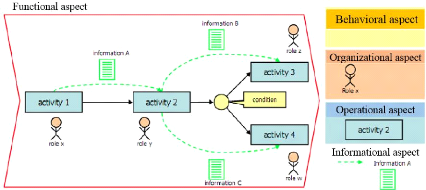
Figure 1.1: Different aspects of a business process [54]
1.2.2 Business Process Management
The efforts to help organizations, in many areas of business,
to manage their process changes have given rise to a new kind of systems,
called 'Business Process Management' (BPM) systems [1]. They have been
widely used and are the best methodology so far. The increasing use of such
systems in companies expresses their undeniable importance as a tool for
automation of their process. Business Process Management Systems are among the
most elaborate systems to define and execute processes. They allow, in
particular, to explicitly describe the methods of carrying out a work process,
to experiment, to measure their quality and to optimize them in order to ensure
the improvement and the reuse of processes [54].
1.2.3 BPM life cycle
The BPM process goes through different phases. The figure
(1.2), illustrate the classical BPM life cycle. The first phase in this life
cycle is the process design phase which is followed by the process
configuration phase, in which, the design is used to configure some
process-aware information system in the configuration phase. After the process
has been running for a while in the enactment phase (process enactment)
and event logs have
7
Business Process and Process Mining
been collected, diagnostics can be used to develop another
(and preferably better) design (process diagnosis).
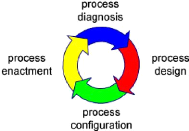
Figure 1.2: BPM life cycle [15].
Adopting this approach is assuming that large information
systems are expected to evolve over time into larger and better systems. In
practice, processes are often implicit (i.e. they are not designed as such, but
emerged from daily practice) or not enforced by any system. However, when these
processes are analyzed, they can be captured by one or different process models
of some sort. Obviously, when capturing and making a process model, mistakes
should be avoided. For that, it is very important to adopt a clear and reliable
business model. This will ensure some important benefits like:
· The possibility to increase the visibility of the
activities, that allows the identification of problems (e.g. bottlenecks) and
areas of potential optimization and improvement;
· The ability to group the activities in "department"
and persons in "roles", in order to better define duties, auditing and
assessment activities.
So, following the previous listed benefits, a process model
should be built around some basic characteristics. The most important one is
that a model should be unambiguous in the sense that the process is
precisely described without leaving uncertainties to the potential reader.
1.2.4 Business processes modeling languages
It exist many languages for business processes modeling. The
most used languages for the specification of business processes are those with
a graph-based representations formalisms. The nodes represent the process's
tasks (or, in some notations, also the states
8
Business Process and Process Mining
and the possible events of the process), and arcs represent
ordering relations between tasks (for example, an arc from node n1 to
n2 represents a dependency in the execution so that n2 is
executed only after n1 ). The most used and adopted graph based
languages are: Petri nets [17, 55] and BPMN [33].
1.2.4.1 Petri Nets
Petri Nets are a formal language that can be used to specify
processes. Since the language has a formal and executable semantics, processes
modeled in terms of a Petri Net can be executed by an information system.
Definition (Petri Net). The authors in [41]
have defined Petri Net as follow:
A Petri Net is a tuple (P, T, F). where: P is a finite
set of places; T is a finite set of transitions, such that P n T = n
and F c (P x T) U (T x P) is a set of directed arcs, called flow
relation.
A Petri Net is a directed graph composed of two types of
nodes: places and transitions. Usually, places are represented as circles and
transitions are represented as rectangles. Petri Nets are bipartite graphs,
meaning that an arc in the net may connect a place to a transition or
vice-versa, but no arc may connect a place to another place or a transition to
another transition. A transition has a number of immediately preceding places
(called its input places) and a number of immediately succeeding places (called
its output places) [24]. The network structure is static, but, governed by the
firing rule, tokens can flow through the network. The state of a Petri Net is
determined by the distribution of tokens over places and is referred to as its
marking. In the initial marking shown in (Figure 1.3), there is only one token,
start is the only marked place. Petri Nets are particularly suited for the
systems behavior modeling in terms of "flow" (the flow of control or flow of
objects or information) and offer an intuitive visualization of the process
model. They have been studied from a theoretical point of view for several
decades, which had led to a number of tools that enable their automated
analysis.
9
Business Process and Process Mining
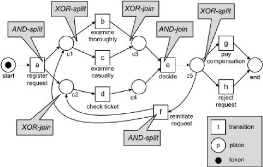
Figure 1.3: A marked Petri net.
Places are containers for tokens and tokens represent the
thing(s) that flow through the system. During the execution of a Petri Net and
at a given point, each place may hold zero, one or multiple tokens. Functions
are used to represent Petri Net states by assigning a number of tokens to each
place in the net. Such functions are called a marking. For example, (Figure 1.4
(i)) depicts a marking of a Petri Net where there is one token in the leftmost
place and no token in any other place. The state of a Petri Net changes when
one of its transitions fires. A transition may only fire if there is at least
one token in each of its input places. In this case, we say that the transition
is enabled.
For instance, in (Figure 1.4(a)), the transition labeled t1
is enabled since this transition has only one input place and this input place
has one token. When a transition fires, it removes one token from each of its
input places and it adds one token to each of its output places. For example,
(Figure 1.4 (b)) depicts the state obtained when transition t1 fires starting
from the marking in (Figure 1.4 (a)). The token in the leftmost place has been
removed, and a token has been added to each of the output places of transition
t1. In a given marking, there may be multiple enabled transitions
simultaneously.
In this situation, any of these enabled transitions may fire
at any time. For example, in (1.4 (b)) there are two transitions enabled: "Send
Invoice" and "Prepare Shipment". Any of these transitions may fire in the next
execution step. Note that when the label attached to a transition is long (e.g.
"Send Invoice") we place the label inside the rectangle representing this
transition. Also, we will sometimes omit the label of a transition altogether.
Transitions without labels correspond to "silent steps" which have no effect on
the outside world, as opposed to a transition such as "Send Invoice".
Business Process and Process Mining

(a) Petri nets in an initial marking

(b) Petri nets after transition t1 fires
Figure 1.4: Petri Nets in two different states.
An important subclass of Petri Nets is the Workflow Nets
(WF-Net), whose most important characteristic is to have a dedicated "start"
and "end".
1.2.4.2 Workflow Nets
Workflow Nets, or WF-Nets, are a subclass of Petri nets,
tailored towards workflow modeling and analysis. For example in [49], several
analysis techniques are presented towards soundness verification of WF-nets.
Basically, WF-nets correspond to P/T-nets with some
structural properties. These structural properties aims at clearly seeing the
initial and final state for each executed case. Furthermore, they ensure that
there are no unreachable parts of the model, i.e.:
· The initial marking marks exactly one place (the
initial place or source place), and this place is the only place without
incoming arcs,
· There is exactly one final place or sink place, i.e. a
place without outgoing arcs,
· Each place or transition is on a path that starts in
the initial place and ends in the final place.
10
Formally, WF-Nets are defined as follows:
Business Process and Process Mining
Definition 1.2.1. (Workflow Net)
A P/T-net g = (P, T, F) is a workflow Net (or
WF-Net) if and only if:
There exists exactly one pj E P,
such that
·pj = 0, i.e. the source place, There
exists exactly one pf E P, such that pf
· =
0, i.e. the sink place, Each place and transition is on a path from
pj to pf .

11
Figure 1.5: Some basic workflow templates that can be modeled
using Petri Net notation.
In the literature, there have been proposed various
correctness criteria for Workflow Nets [26]. One of the most used criterion is
soundness, which is defined as follows:
Definition 1.2.2. (Classical Soundness) Let N=
(P, T, F, A, l) be a Workflow Net with input place j and
output place o. N is sound if and only if:
· Safeness: (N, [j]) is safe, i.e., places cannot
hold multiple tokens at the same time.
· Proper completion: for any marking M E [N, [j]],
o E M implies M = [o].
· Option to complete: for any marking M E [N, [j]]
, [o] E [N, M].
· Absence of dead parts: (N, [j]) contains no
dead transitions (i.e., for any t E T ,there is a firing
sequence enabling t).
1.2.4.3 Causal Nets (C-Nets)
To represent activities, process modeling languages have
typical elements, but often they also have extra elements to specify the
relation between activities (semantics). For instance, to represent states of
the process and to model the control-flow, Petri Net requires
12
Business Process and Process Mining
places. BPMN has gateways and events. All of these extra
elements do not leave a trace in event logs, i.e., no events are generated by
occurrence of elements other than the ones representing activities. Thus, given
an event log, process discovery techniques must also "guess" the existence of
such elements in order to describe the observed behavior in the log correctly.
This causes several problems as the discovered process model is often unable to
represent the underlying process well, e.g., the model is overly complex
because all kinds of model elements need to be introduced without a direct
relation to the event log (e.g., places, gateways, and events) [44].
Furthermore, generic process modeling languages often allow for undesired
behavior such as deadlocks and live-locks.
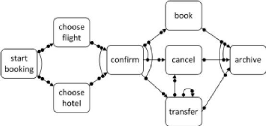
Figure 1.6: A causal net example.
Causal nets are a process model representation tailored
towards process mining [44]. In causal net, activities are represented by nodes
and the dependencies between them are represented by arcs. Each causal net is
characterized by a start and end activity. The activities semantics' are shown
by their input and output bindings.
1.2.4.4 BPMN
Multiple tool vendors have been in need for a unique
standardization of a single notation to Business Process Modeling. They have
made an agreement among them and they have proposed the Business Process
Modeling and Notation) [33]. As a benefit of BPMN, it is used in many real
cases and many tools adopt it daily. BPMN provides a graphical notation to
describe business processes, which is both intuitive and powerful (it is able
to represent complex process structure). It is possible to map a BPMN diagram
to an execution language, BPEL (Business Process Execution
Language)1.
'Business Process Execution Language (BPEL), short for Web
Services Business Process Execution Language (WS-BPEL) is an OASIS standard
executable language for specifying actions within business
processes with web services. Processes in BPEL export and
import information by using web service interfaces exclusively
Business Process and Process Mining
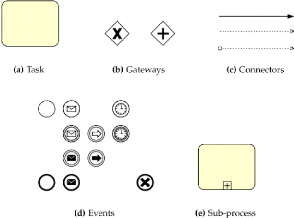
13
Figure 1.7: Example of some basic components, used to model a
business process using BPMN notation.
The main components of a BPMN diagram (Figure 1.7) are as
follow:
Events: an event is defined as
something that "happens" during the course of a process; typically an event has
a cause (trigger) and an impact (result). Each event is represented with a
circle (containing an icon, to specify some details), as in Figure (1.7 (d)).
It exist three types of events: start (single narrow border), intermediate
(single thick border) and end (double narrow border).
Activities: The work done by a
company is identified by a generic term which is Activity. In the graphical
representation, rounded rectangles are used to identify activities. There are
few types of activity like tasks (a single unit of work, (Figure 1.7 (a))) and
subprocesses (used to hide different levels of abstraction of the work, (Figure
1.7 (e))).
Gateway: A Gateway is used as a
structure to control the divergences and convergences of the flow of the
process (fork, merge and join). Internal markers like (exclusive, event based,
inclusive, complex and parallel) are used to identify the type of gateway, like
"exclusive" (Figure 1.7 (b)).
Sequence and message flows and associations
: They are used as connectors between components of the
graph. The order of the activities is indicated by a sequence flow (Figure 1.7
(c),top). The flow of the messages (as they are prepared,
14
Business Process and Process Mining
sent and received) between participants is shown by a Message
Flow (Figure 1.7 (c),bottom). Associations (Figure 1.7 (c), middle) are used to
connect artifacts with other elements of the graph.
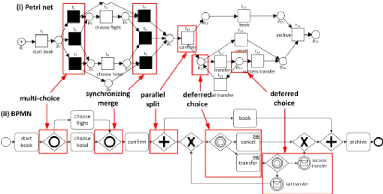
Figure 1.8: A Petri Net and a BPMN model that exhibit similar
set of traces, annotated with some control-flow patterns that exist in both
models.
Unlike Petri Nets, BPMN provides abundance of notations to
represent complex patterns. For example in Figure (1.8), both multi-choice and
synchronizing merge patterns are each represented by a dedicated gateway. There
are many ways to express the same behavior in BPMN. As illustrated in Figure
(1.8) it is possible to represent the same deferred choice pattern by two
different alternatives: using tasks with type "receive", or using events.
Despite of its popular use, BPMN also has some drawbacks, for instance, the
states are not explicitly defined.
1.3 Process Mining
Process mining is the art of extracting non-trivial and useful
information about processes from event logs. As illustrated in Figure (1.9),
process mining closes the process modeling loop by allowing the discovery,
analysis and extension of (process) models from event logs. One aspect of
process mining is control-flow discovery, i.e., automatically constructing a
process model which describes the causal dependencies between activities [45].
The basic idea of control-flow discovery is very simple: it consist on
automatically construct a suitable process model "describing the behavior" from
a given event log containing a set of traces. The second aspect is the
organizational aspect, which focuses on who performed
15
Business Process and Process Mining
which actions [47]. This can give insights in the roles and
organizational units or in the relations between individual performers (i.e. a
social network).
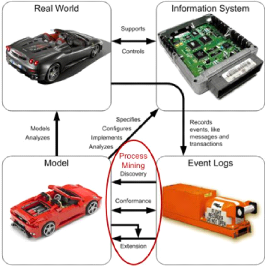
Figure 1.9: From event logs to models via process mining
1.3.1 Event logs
An event log consists of events that pertain to process
instances. A process instance is defined as a logical grouping of activities
whose state changes are recorded as events. An Event logs shows occurrences of
events at specific moments in time, where each event refers to a specific
process and an instance thereof, i.e. a case. An Event log could show the
events that occur in a specific machine that produces computer chips, or it
could show the different departments visited by a patient in a hospital. Event
logs, serves as a basis for process analysis. It assumes that it is possible to
record events such that:
1. Each event refers to an activity (i.e., a well-defined step
in the process);
2. Each event refers to a case (i.e., a process instance);
3. Each event can have a performer also referred to as
originator (the actor executing or initiating the activity);
4. Events have a timestamp and are totally ordered.
16
Business Process and Process Mining
Table (1.1) shows an example of a log involving 19 events, 5
activities, and 6 originators.
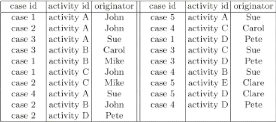
Table 1.1: An event log (audit trail).
Some event logs contain more information (more than the set of
information shown in table (1.1)) on the case itself, i.e., data elements
referring to properties of the case. They can logs every modification of some
data element. Event logs are used as the beginning or starting point for
mining.
1.3.2 Log filtering
The most potential next step for many applications after
getting the events log is to filter it, i.e. to transform the log into another
process log. Fundamentally, filtering a log is based on two basic actions :
adding information to, or removing information from the process log.
There are different reasons why filtering is necessary. It is
done for two main reasons: cleaning the data or narrowing down the analysis.
Information systems are not free of errors and data may be recorded that does
not reflect real activities. Errors can result from malfunctioning programs but
also from user disruption or hardware failures that leads to erroneous records
in the event log. Other errors can occur without incorrect processing. A log
filter also can be considered as a function that transforms one process
instance into another process instance, by adding or removing information. By
filtering event logs, we obtain a process log that is easier to analyze or mine
and less sensitive to noise.
The authors in [6] have defined log filtering as a function f
where :
Let A be a set of activities and E be a set
of event types, such that T ? (A × E) is a set of log events and
W ? P(T*) a process log over T. Furthermore, let
A' also be a set
17
Business Process and Process Mining
of activities and E' also be a set of
event types, such that T' Ç (A'
x E') is a set of log events. So f is
defined as follow:
f : P(T*) P(T'*), i.e. a function
that takes a trace as input and produces a different
trace as output.
1.3.3 Process Mining Perspectives
There are many important and interesting fields/perspectives
for Process mining research, but three of them deserve special emphasis:
- Process perspective: Process perspectives focuses on the
control-flow, i.e., tasks ordering. This perspective aims at finding a good
characterization of all possible paths, e.g., expressed in terms of a Petri
Net, an Event-driven Process Chain (EPC), or a UML activity diagram.
- Organizational perspective: Organizational perspective
focuses on the originator field, i.e., which performers are involved and how
are they related. This perspective aims at either to structure the organization
by classifying people in terms of roles and organizational units or to show
relations between individual performers (i.e., build a social network).
- Case perspective: Case perspective focuses on properties of
cases. The cases paths in the process or their working originators can be used
to characterize them. However, cases can also be characterized by the values of
the corresponding data elements. For instance, if a case represents a
replenishment order, it is interesting to know the supplier or the number of
products ordered.
The above perspectives can be obtained as answers to the
following kind of questions respectively:
· How? : can be used for the process perspective;
· Who? : can be used for the organizational perspective;
· What? : can be used for the case perspective.
18
Business Process and Process Mining
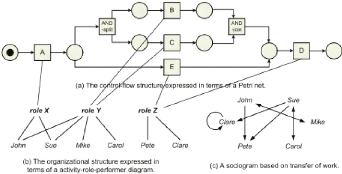
Figure 1.10: Some mining results for the process perspective (a)
and organizational(b,c).
According to the authors [12, 50, 51], we can figure out three
orthogonal aspects from the above perspectives:
1. Discovery of process knowledge like process
models;
2. Conformance checking, i.e. measure the
conformance between modeled behavior (defined process models) and observed
behavior (process execution present in logs);
3. Extension, i.e., an a-priori model is enrich and
extended with new aspects and perspective of an event log.
Process mining is mainly used to the discovery of
process models. Therefore, much investigation has been performed in order
to improve the produced models. However, many issues still complicate the
discovery of comprehensible models and there is a need to consider
them and provide solutions. The models generated tend to be very confusing and
difficult to understand in case of processes with a lot of
different cases and high diversity of behavior. These models are
usually called spaghetti models [10].
1.3.4 Process Mining as Control-Flow Discovery
The term process discovery was introduced by Cook and Wolf
[7], who apply it in the field of software engineering. They have
proposed a Markov algorithm which can only discover sequential patterns. This
is due to the fact that Markov chains cannot elegantly represent concurrent
behavior. The idea of applying process discovery in the context of
workflow management systems stems from Agrawal et al. [1].
19
Business Process and Process Mining
The value of process discovery for the general purpose of
process mining [23] is well illustrated by the plugins within the ProM
framework. It consists [53], of a large number of plugins for the analysis of
event logs. The Conformance Checker plugin [29], for instance, allows
identifying the discrepancies between an idealized process model and an event
log. Moreover, with a model that accurately describes the event log, it becomes
possible to use the time-information in an event log for the purpose of
performance analysis, using, for instance, the Performance Analysis with Petri
nets plugin.
Before investigating how some related works approaches are
doing, we present bellow some basic notions:
· Invisible Tasks Refer to the type of
invisible tasks that the technique can tackle. For instance, invisible tasks
can be used to skip other tasks in a choice situation (see Figure 1.11(f),
where B is skipped). Other invisible tasks are used for more elaborate routing
constructs like split/join points in the model (see Figure 1.11(g), where the
AND-split and AND-join are invisible "routing" tasks.).
· Duplicate Tasks Can be in sequence in
a process model (see Figure 1.11(h)), or they can be in parallel branches of a
process model (see Figure 1.11(i)).
· Non-free-choice Shows if the
technique can mine non-free-choice constructs that can be detected by looking
at local information at the log or non-local one. A non-local non-free-choice
construct cannot be detected by only looking at the direct successors and
predecessors (the local context) of a task in a log. The figures 1.11(c) and
1.11(d) both show a non-free-choice construct involving the tasks A, B, C, D
and E. However, the Figure 1.11(d) illustrate a local non-free-choice, while
the one in Figure 1.11(c) is not. Note that the task A never directly precedes
the task C and a similar situation holds for the tasks B and D in any trace of
a log for the model in Figure 1.11(c).
· Loops Points out if the technique can
mine only block-structured loops, or can handle arbitrary types of loops. For
instance, Figure 1.11(e) shows a loop that is not block-structured.
· Sequence, choice and parallelism
Respectively show if the technique can mine tasks that are in a
sequential, choice or concurrent control- flow pattern structure.
· The noise The event log contains rare
and infrequent behavior not representative for the typical behavior of the
process2.
2Note that the definition of noise may be a bit
counter-intuitive. Sometimes the term "noise" is used to refer to incorrectly
logged events, i.e., errors that occurred while recording the events.
20
Business Process and Process Mining
· Incompleteness The event log contains
too few events to be able to discover some of the underlying control-flow
structures.
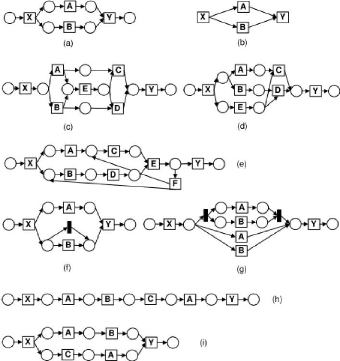
Figure 1.11: Illustration of the main control-flow
patterns.
The remainder of this section describes the process discovery
algorithms that have been applied in the context of Control-flow.
1.3.4.1 The
á-algorithm
A well known process discovery algorithm that is based on the
log relations is called the á-algorithm. Aalst et al.[35] have proved
that á-algorithm can learn an important class of Workflow Nets, called
Structured Workflow Nets, from complete event logs. The á-algorithm can
be considered as a theoretical learner. In order to discover a Workflow Net
from logs, it is necessary to establish the ordering between the transitions of
this workflow. These relations will later be used in order to find places and
connection between the transitions and these places. These relations, between
two activities x and y are:
21
Business Process and Process Mining
· Direct succession x > y: x > y ?
there are in log sub-traces...xy,
· Causality x -? y: x -? y
? x > y ?y x (i.e: if there are traces
...xy... and no traces ...yx...),
· Parallel x k y: x k y
? x > y ?y > x ( i.e. can be both
...xy... and ...yx...),
· Unrelated x#y: x#y ? x y
?y x (i.e. there are no traces ...xy... nor
...yx...). The set of all relations for a log L is called the
footprint of L.
With these relations, the á-algorithm is defined
as follows:
Algorithm 1 á-algorithm
Require: á(L) :
1: extract all transition names from L to set
T
2: let TI be the set of all initial transitions and
TO the set of all end transitions
3: find all pairs of sets (A, B) such that:
· tA ? A should be connected to all
tB ? B via some place p,
· ?a ? A and ?b ? B
holds a -? b,
· ?a1, a2 ? A: a1#a2
and ?b1, b2 ? B: b1#b2.
4: once found all such sets, we retain only the maximal ones:
· a maximal set contains the maximal possible number of
elements that can be connected via single place.
5: for each such pair (A, B), we connect all
elements from A with all elements from B with one single
place pA,B
6: then we also connect appropriate transitions with the
input and output places.
7: finally we connect the start place j to all
transitions from TI.
8: and all transitions from TO with the final state
o.
Example of how á-algorithm works: Let us
consider the log L=[abcd,acbd,aed]. Its footprint is:
|
a
|
b
|
c
|
d
|
e
|
|
a
|
#
|
-?
|
-?
|
#
|
-?
|
|
b
|
?-
|
#
|
k
|
-?
|
#
|
|
c
|
?-
|
k
|
#
|
-?
|
#
|
|
d
|
#
|
?-
|
?-
|
#
|
?-
|
|
e
|
?-
|
#
|
#
|
-?
|
#
|
22
Business Process and Process Mining
· TI : the set of all first transitions in the
log,
o in the table, for such transitions we don't have any incoming
edges,
o i.e. it has only f- , no -? in its column,
o TI= {a}.
· To : the set of all last transitions
in the log, o no outcoming edges, only incoming - in the rows,
o To= {d}
With this table, using -? and relations we can draw the following
graph (a directed edge represents -? relation, undirected double edge
represents relation):
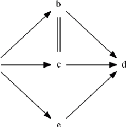
With this graph we can enumerate the maximal sets A and B. Recall
that for sets A and B :
· ?a1, a2 E A:
a1#a2,
· ?b1, b2 E B:
b1#b2,
· ?a1 E A, ?b1 E B :
a1 -? b1.
|
A
|
B
|
(1)
|
{a}
|
{b, e}
|
(2)
|
{a}
|
{c,e}
|
(3)
|
{b, e}
|
{d}
|
(4)
|
{c, e}
|
{d}
|
|
Note that b and c cannot belong to the same
set( they are parallel).
Based on these sets:
· we add 4 places for each pair (A, B) to
connect all elements from A with all elements from B with one
place,
· and we add 2 more places: the start place j
and the final state o.
23
Business Process and Process Mining
|
A
|
B
|
|
p1
|
{a}
|
{b,e}
|
|
|
|
p2
|
{a}
|
{c,e}
|
|
|
|
p3
|
{b,e}
|
{d}
|
|
|
|
|
p4
|
{c,e}
|
{d}
|
|
|
|
|
|
So we have:

The á-algorithm is remarkably simple, in the
sense that it uses only the information in the ordering relations to generate a
WF-Net. It assumes event logs to be complete with respect to all allowable
binary sequences and assumes that the event log does not contain any noise.
Therefore, the á-algorithm is sensitive to noise and
incompleteness of event logs. Moreover, the original
á-algorithm was incapable of discovering short loops or
non-local, non-free choice constructs. Alves et al. [2] have extended the
á-algorithm to mine short loops and called it
á+-algorithm.
1.3.4.2 The
á+-algorithm
Alves et al. [2], have introduced new ordering relations such
as:
· a 4 b ? there is a subsequence
...aba... in the logs,
· ab ? there are sequences ...aba...
and ...bab... And they have redefine the relations that cause the
error:
· a -? b ? a > b ? (b a V ab), (this way we
can correctly identify the follow relation when there's a loop of length 2)
24
Business Process and Process Mining
· a b ? a > b ? b > a ? no ab (by adding the
last condition way we don't misidentify the parallel relation)
· therefore at this step we assume that the net is
one-loop-free - i.e. it does not contain loops of length 1
· if it's not the case, we can turn our Worflow Net into
one-loop-free by removing all transitions that create these loops.
Algorithm 2
á+-algorithm
Require:
á+(W)
:
1: let T be all transitions found in the log
W
2: identify all one-loop transitions and put them into set
L1L
3: let Ti be all non-one-loop transitions: Ti +- T
- L1L
4: let FL1L
be the set of all arcs to transitions from
L1L : it consists of:
· all transitions a that happen before t:
a E Ti,s.t a > t,
· all transitions b that happen before t:
b E Ti,s.t t > b,
5: now remove all occurrences of transitions t E
L1L from the log W, let the result be
W-L1L
6: run the á- algorithm on
W-L1L
7: reconnect one-loop transitions back: add all transitions and
from L1L and arcs from
FL1L to transitions and
arcs discovered by á
Wen et al. [52] made an extension for detecting implicit
dependencies, for detecting non-local, non-free choice constructs. None of the
algorithms can detect duplicate activities. The main reason why the
á-algorithms are sensitive to noise, is that they does not take
into account the frequency of binary sequences that occur in event logs.
Weijters et al. [50] have developed a robust, heuristic-based method for
process discovery, called heuristics miner.
1.3.4.3 The Heuristics algorithm
Heuristics Miner is a Process Mining algorithm that uses a
statistical approach to mine the dependency relations among activities
represented by logs. It focuses on the control flow perspective and generates a
process model in the form of a Heuristics Net for the given event log. The
formal approaches like the alpha algorithm i.e. an algorithm for mining event
logs and producing a process model, presupposes that the mined log must be
complete and there should not be any noise in the log. However, this is not
practically
25
Business Process and Process Mining
possible. The heuristics miner algorithm was designed to make
use of a frequency based metric and so it is less sensitive to noise and the
incompleteness of logs.
The Heuristics Miner mines the control flow perspective of a
process model. To do so, it only considers the order of the events within a
case. In other words, the order of events among cases isn't important. For
instance for the log in the log file only the fields case id, timestamp and
activity are considered during the mining. The timestamp of an activity is used
to calculate these orderings. The main difference with the á- algorithm
is the usage of statistical measures (together with acceptance thresholds,
parameters of the algorithm) for the determination of the presence of such
relations.
The algorithm can be divided in three main phases: the
identification of the graph of the dependencies among activities; the
identification of the type of the split/join (each of them can be an AND or a
XOR split); the identification of the "long distance dependencies". An example
of measure calculated by the algorithm is the "dependency measure" that
calculates the likelihood of a dependency between an activity a and b:
a == b = |a>b|-|b>a|
|a>b|+|b>a|+1, where:
· a > b indicates the number of times that the
activity a is directly followed by b into the log.
Another measure is the "AND-measure" which is used to
discriminate between AND and XOR splits:
a == (b ? c) = |b>c|+|c>b|
|a>b|+|a>c|+1,
If two dependencies are observed, e.g. a -+ b and a -+ c, it
is necessary to discriminate if a is and AND or a XOR split. The above formula
is used for this purpose: if the resulting value is above a given threshold
(parameter of the algorithm), then a is considered as an AND split, otherwise
as XOR.
This algorithm can discover short loops, but it is not
capable of detecting non-local, non-free choice as it does not consider
non-local dependencies within an event log. Moreover, heuristics miner cannot
detect duplicate activities. Alves de Medeiros et al.[36]) describe a genetic
algorithm for process discovery.
1.3.4.4 The Genetic algorithm
Another approach to mine processes by mimicking the process
of evolution in biological systems is called Genetic Mining. The main idea is
that there is a search space that contains some solution point(s) to be found
by the genetic algorithm. The algorithm starts by randomly distributing a
finite number of points into this search space. Every point in the search space
is called an individual and the finite set of points at a given
26
Business Process and Process Mining
moment in time is called a population. Every
individual has an internal representation and the quality of an individual is
evaluated by the fitness measure. The search continues in an iterative
process that creates new individuals in the search space by recombining and/or
mutating existing individuals of a given population.
A new generation is obtained at every new iteration
of a Genetic algorithm. The parts that constitute the internal representation
of individuals constitute the genetic material of a population.
Genetic operators are used to perform recombination and/or
modification of the genetic material of individuals. Usually, there are two
types of genetic operators:
· Crossover: the crossover operator recombines
two individuals (or two parents) in a population to create two new individuals
(or two offsprings) for the next population (or generation),
· Mutation: the mutation operator randomly
modifies parts of individuals in the population.
In both cases, there is a selection criterion to choose the
individuals that may undergo crossover and/or mutation. To guarantee that good
genetic material will not be lost, a number of the best individuals in a
population (the elite) is usually directly copied to the next generation. The
search proceeds with the creation of generations (or new populations) until
certain stop criteria are met. For instance, it is common practice to set the
maximum amount of generations (or new populations) that can be created during
the search performed by the genetic algorithm, so that the search process ends
even when no individual with maximal fitness is found [2].
The genetic miner is capable of detecting non-local patterns
in the event log and is described to be fairly robust to noise. The goal of
genetic mining is to get a heuristic net with the highest possible fitness,
i.e. a net that best describes the log under consideration.
Aalst et al. [38] present a two-phases approach to process
discovery that allows to configure when states or state transitions are
considered to be similar. The ability to manipulate similarity is a good
approach to deal with incomplete event logs. In particular, several criteria
can be considered for defining similarity of behavior and states: the inclusion
of future or past events, the maximum horizon, the activities that determine
state, whether ordering matters, the activities that visibly can bring about
state changes, etcetera. Using these criteria, a configurable finite state
machine can be constructed from the event log. In a second phase, the finite
state machine is folded into regions using the existing theory of regions
[8].
27
Business Process and Process Mining
Schimm [31] has developed a mining tool suitable for
discovering hierarchically structured workflow processes. This requires all
splits and joins to be balanced. However, in contrast to other approaches, he
tries to generate a complete and minimal model, i.e. the model can reproduce
the log and there is no smaller model that can do so. Like Pinter et al. in
[22], Schimm assumes that events either refer to the start or completion of an
activity and he uses this information to detect explicit parallelism.
1.4 Evaluation metrics of Business Processes
In general, every scientific studies give rise to a new
solutions and/or approaches. New solutions means new possibilities and
opportunities, which led to an important problem: which is the best solution to
adopt and how it is possible to compare the new solution against the others,
already available in the literature?.
Evaluation of business processes and its involved elements is
important as it is used as a tool to control and improve the processes.
Different methods are used for this purpose which ranges from economics,
statistics fields to computer science. In computer science, focus is to provide
support in carrying out business operations (automation), storage (databases),
computations (mining methods). Here, we focus on the evaluation of the
computation aspect of business processes mining algorithm.
1.4.1 Performance of a Process Mining Algorithm
Since there is continually new process mining algorithms with
different characteristics and factors which influence their performance, it is
important to be able to select the best algorithms according different
criteria. Performance of processes is measured in terms of performance
indicators, e.g. throughput time. Process mining present ways to deal with
these indicators.
1.4.2 Evaluating the discovered process
Many evaluation criteria can be used to measure the
performance of an algorithm comparing to another. It depends on the aims of the
use or the evaluation of the algorithm. In [54], the authors have adopted four
main dimensions of quality criteria that can be used to specify different
quality aspects of reconstructed process models: fitness, simplicity, precision
and generalization.
28
Business Process and Process Mining
Fitness: the fitness aspect addresses the
ability of a model to capture all the recorded behavior in the event log.
Precision: the precision points out if a
process is overly general (a model that can generate many more sequences of
activities with respect to the observations in the log). It requires that the
model does not allow additional behavior very different from the behavior
recorded in the event log.
Generalization: the generalization denotes if
a model is overly precise. The discovered model should generalize the example
behavior seen in the event log (a model that can produce only the sequence of
activities observed in the log, with no variation allowed).
Simplicity: simplicity means that a process
model is not exclusively restricted to display the eventually limited record of
observed behavior in the event log but that it provides an abstraction and
generalizes from individual process instances.
The above dimensions can be used to identify the aspects
highlighted in a model. For instance, in (Figure 1.12) four processes are
displayed with different levels for the different evaluation dimensions.
Suppose, as reference model, the one in (Figure 1.12 (a)), and assume that a
log it can generate is presented in Table (1.2).
|
1207
|
ABDEI
|
|
145
|
ACDGHFI
|
|
56
|
ACGDHFI
|
|
28
|
ACHDFI
|
|
23
|
ACDHFI
|
Table 1.2: Example of log traces, generated from the
executions of the process presented in (Figure 1.12 (a)).
In (Figure 1.12 (b)), the concerned process is called "flower
model". It allows any possible sequence of activities and, essentially, does
not define an order among them. For this reason it has very low precision, even
if it has high fitness, generalization and structure.
The process (Figure 1.12 (c)) is just the most frequent
sequence observed in the log, so it has medium precision and high structure but
low fitness and generalization. In (Figure 1.12 (d)) the process is a
"complete" model, where all the possible observed behaviors in the log can be
reproduce without any flexibility. This model has high fitness and precision
but low generalization and structure.
29
Business Process and Process Mining
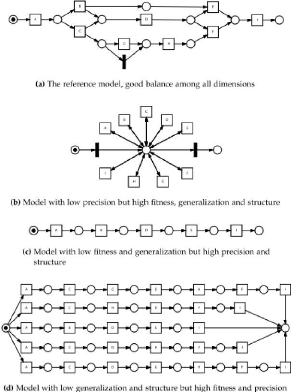
Figure 1.12: Four process where different dimensions are
pointed out (inspired by Fig. 2 of [28]). The (a) model
represents the original process, that generates the log of Table 2.2;
in this case all the dimensions are correctly highlighted; (b) is a
model with a low fitness; (c) has low precision and (d) has low generalization
and structure.
In the remaining part of the section some metrics are
presented. In particular, it is possible to distinguish between metrics
model-to-log, that compare a model with a log and metrics model-to-model that
compare two models.
1.4.2.1 Model-to-log Metrics
Using Process Mining techniques, these metrics aim at
comparing log with the process model that has been derived.
According to [54], these metrics can be grouped in three main
categories as follow :
30
Business Process and Process Mining
1- Metrics to quantify fitness
Fitness considers also the "problems"
happened during replay (e.g. missing or remaining tokens in a Petri Net) so
that actions that can't be activated are punished as the action that remains
active in an improper way [29].
Completeness very close to the Fitness,
takes into account trace frequency as weights when the log is replayed [36].
Parsing Measure is defined as the number of
correct parsed traces divided by the number of traces in the event log [21].
2- Metrics to quantify
precision/generalization
Soundness calculates the percentage of
traces that can be generated by a model and are in a log (so, the log should
contain all the possible traces) [10].
Behavioral Appropriateness evaluates how
much behavior is allowed by the model but is never used in the log of observed
executions [29].
ETC Precision evaluates the precision by
counting the number of times that the model deviates from the log (by
considering the possible "escaping edges") [11].
3- Metrics to quantify structure
Structural Appropriateness measures if a
model is less compact than the necessary, so extra alternative duplicated tasks
(or redundant and hidden tasks) are punished [29].
1.4.2.2 Model-to-model Metrics
Unlike the first category of metrics, Model-to-model Metrics
aim at comparing two models, one against the other. Authors in [9] have
enumerated four types of metrics:
Structural Similarity Aims at measuring the "graph edit
distance" that is the minimum number of graph edit operations (e.g. node
deletion or insertion, node substitution, and edge deletion or insertion) that
are necessary to get from one graph to the other [9].
31
Business Process and Process Mining
Label Matching Similarity Is based on a
pairwise comparison of node labels: an optimal mapping equivalence between the
nodes is calculated and the score is the sum of all label similarity of matched
pairs of nodes [9].
Dependency Difference Metric Counts the
number of edge discrepancies between two dependency graph (binary tuple of
nodes and edges) [5],
Process Similarity (High-level Change
Operations) Counts the changes required to transform a process into another
one, with 'high level' changes (not adding or removing edges, but 'adding
activity between two', and so on).
1.5 Conclusion
In this chapter we have introduced a different techniques of
process mining. Recall that the aim of process discovery is to aid a process
designer in improving the support for a process by an information system.
Hence, it heavily depends on the specific information that can be taken from an
information system, which process discovery approach best suits the
designer.
In this chapter we presented again different approaches for
the evaluation of process models, in particular a model-to-model and a
model-to-log metric. For most of this techniques, good tool support is
essential, such as ProM.
32
Chapter2
Process Mining Tools
2.1 Introduction
Process mining is a process management technique that allows
for the analysis of business processes based on event logs. The basic idea is
to extract knowledge from event logs recorded by an information system. Process
mining aims at improving this by providing techniques and tools for discovering
process, control, data, organizational, and social structures from event logs.
Without these techniques it is difficult to obtain a valuable information.
Many free and commercial software's framework for the use and
implementation of process mining algorithms have been developed. In this
chapter we will focuses on the ProM framework which is largely used because of
its extensibility and the fact that it supports a wide variety of process
mining techniques in the form of plug-ins.
This chapter is devoted to the presentation of the ProM
framework. First we gives an overview on what consist log filtering and how to
do some basic log filtering orations in ProM. Then we present some mining
plug-ins, which are implementation of different mining algorithms. After that,
we shows that it is possible to get much more information's by applying some
analysis techniques on the mining results. And then, we present another very
important kind of plug-ins which provide to ProM the ability to convert one
model into another model. Finally we ends this chapter by a short
conclusion.
2.2 ProM Architecture
The (Pro)cess (M)ining framework (ProM) is an extensible
framework that supports a wide variety of process mining techniques in the form
of plug-ins. It is an independent
33
Process Mining Tools
platform as it is implemented in Java. It was developed as a
framework for process mining but now it becomes much more versatile, currently
including many analysis and conversion algorithms, as well as import and export
functionality for many formalisms, such as EPCs and Petri Nets. Figure 2.1
presents an overview of the ProM Framework architecture, it shows the relations
between the framework, the plug-ins and the event log.
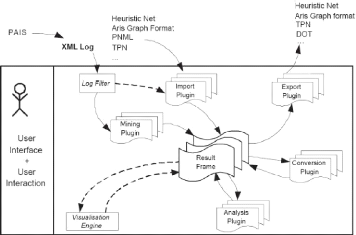
Figure 2.1: Overview of the ProM Framework. (adapted from
[41])
As shown in Figure 2.1, the event logs are generated by
Process-aware Information Systems (PAIS) [12]. To read an event logs, ProM
framework uses the Log Filter, and it can also perform some filtering tasks to
those logs before performing any other task. As (Figure 2.1) shows, the ProM
framework allows to use five different types of plug-ins:
· Import plug-ins: This king of
plug-ins are used to load a wide variety of models.
· Mining plug-ins: Many
different mining algorithms are implemented in this kind of plug-ins, e.g.,
mining algorithms that construct a Petri Net based on some event log.
· Analysis plug-ins: This
family of plug-ins implement some property analysis on some mining result. For
instance, for Petri Nets there is a technique which constructs place
invariants, transition invariants, and a cover ability graph.
· Conversion plug-ins: The
main offered functionality by these plug-ins is the ability to transform the
mining results into another format, e.g., from BPMN to Petri Nets.
34
Process Mining Tools
· Export plug-ins: Export
plug-ins are used as final step. They offer and implement some "save as"
functionality for some objects (such as graphs). For instance, there are
plug-ins to save EPCs, Petri Nets... etc.
2.3 Log Filters
We have seen in section 1.3.2, that the concept of a log
filter refers to a function that typically transforms one process instance into
another process instance. Many of log filters have been developed. In the rest
of this section, we discuss and introduce on what consist a log filter and how
filters are applied to a log.
Filtering logs is a procedure by which a log is made easier to
analyze and typically less sensitive to noise. This is done by using different
kind of options. For instance, in ProM, the option "keep" is used to keep all
tasks of a certain event (Figure 2.2), also, the option "remove" allows to omit
the tasks with a certain event type from a trace, and the option "discard
instance" allows to discard all traces with a certain event type.

Figure 2.2: Log filter Screenshot (In ProM).
In ProM options can be selected by clicking on an event type.
The Start Events filters the log so that only the traces (or cases)
that start with the indicated tasks are kept. The End Events works in
a similar way, but the filtering is done with respect to the final tasks in the
log trace. The Event filter is used to set which events to keep in the
log.
Filtering logs, and instead of removing information, allows to
add information. For instance, if assumption is made that all cases start and
end with the same log event, a log filter could add an initial event, and end
event to each instance of a valid assumption.
35
Process Mining Tools
2.3.1 Adding artificial 'start' and 'end' events
Figure 2.3 shows the obtained process model for a call center
example, using the Fuzzy Miner.
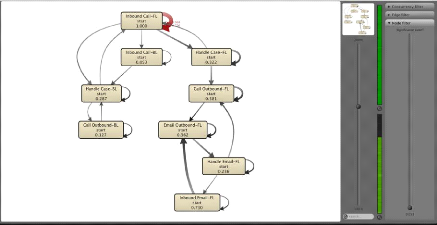
Figure 2.3: Process model using the Fuzzy Miner on a non
filtered event log.
As we can see in the obtained process model, it is not easy at
all to see where the process starts and where it ends. There is no clear
beginning or end point because all of the activities are connected. To create a
clear start and end point in a process models, we can use the so-called "
Adding artificial 'start' and 'end' events" in ProM6.
The figure 2.4, shows the obtained process model after
filtering the event log used in the process model of the figure 2.3.
36
Process Mining Tools
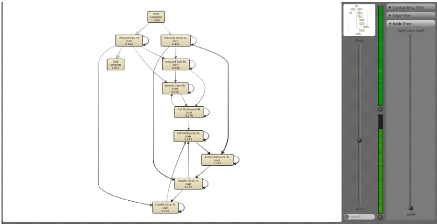
Figure 2.4: Process model after filtering the event log
Now, the main path of the process is clearly visible. Most
process instances are handled by an incoming call at the front line and are
then directly completed.
Example 2 (Adding End events) : The Figure
2.5 illustrate the result of generating a model using the heuristic miner. It
is clearly visible that there is two 'End' events.

Figure 2.5: Process model using the heuristic miner before
filtering.
To create only one clear end point in the process model, In
ProM 6, we can use the so-called "Add End Artificial Events". By doing this,
when discovering a process model based on the filtered log, we get the
following process model (Figure 2.6):
37
Process Mining Tools

Figure 2.6: Process model using the heuristic miner after
filtering.
2.3.2 Duplicate Task filter
In an event log, it can happen that two events are directly
repeated with the same name. Duplicate Task filter (Figure 2.7) allows to
remove such a direct repetitions.
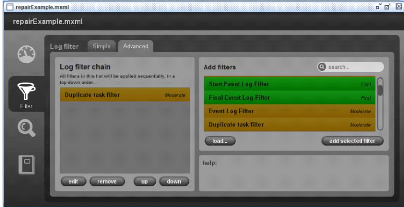
Figure 2.7: Duplicate Task filter.
2.3.3 Remove attributes with empty value
Another important feature in ProM is the ability to remove all
the attributes with an empty value (Figure 2.8). This provide the advantage to
keep only events that have a certain attribute value. But it does not always
work reliably, so it is recommended to make sure to check the effect of the
filter in the Inspector.
38
Process Mining Tools
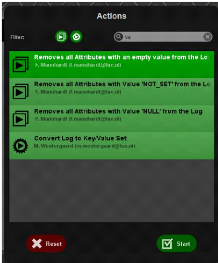
Figure 2.8: Removing attributes with empty value.
2.3.4 Enhanced Event Log filter
Frequency also can be used as a basic parameter in log
filtering (Figure 2.9). Events and process instances can be filtered based on
an activity-based frequency percentage threshold. This is particularly useful
if there are hundreds of different events to, for instance, focus only on
activities that occur in most of the cases.
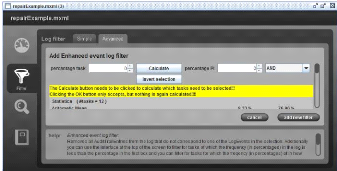
Figure 2.9: Enhanced Event Log filter.
39
Process Mining Tools
2.3.5 Time based log filter
Another technique to log filtering is by using time as a basic
parameter. The time-based log filter technique uses the timestamp to filter:
traces by duration or traces by starting time (as shown in Figure 2.10).
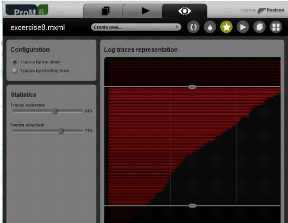
Figure 2.10: Time based log filter.
2.4 Mining Tools
Different types of process mining tools are available, each
with their own strengths and weaknesses. Mining tools are an implementation of
mining algorithms. Tools like ProM offer an easy way to use the different
mining techniques. Some of the control-flow discovery tools include a plenty of
plug-ins.
2.4.1 á-algorithm
plug-in
It implements the á-algorithm [30], which proceed by
constructing a Petri Net that models the workflow of the process (Figure 2.11).
By assuming that the log is complete (all possible behavior is present), the
algorithm establishes a set of relations between tasks. The main limitations of
the á-algorithm are: it is not robust to noise and it cannot mine
processes with short-loops or duplicate tasks. Several works have been done to
extend this algorithm and to provide solutions for its limitations like the
work in [48], in which, the authors have proposed an extension in order to be
able to mine short-loops.
40
Process Mining Tools
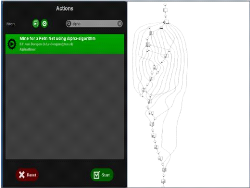
Figure 2.11: alpha miner.
2.4.2 Tshinghua-á-algorithm
plug-in
Which uses timestamps in the log files to construct a Petri
Net (Figure 2.12). It is related to the á-algorithm, but uses a
different approach. Details can be found in [51].
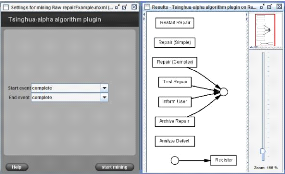
Figure 2.12: Tshinghua alpha miner.
2.4.3 Heuristics miner plug-in
In this plug-in [50], the Heuristics miner algorithm extend
the alpha algorithm by considering the frequency of traces in the log. It can
deal with noise, by only expressing the main behavior present in a log. To do
so, it only considers the order of the events within a case. In other words,
the order of events among cases isn't important.
41
Process Mining Tools
The figure 2.13, illustrate the result of using the heuristic
miner algorithm (In ProM framework) on the log example illustrated in the table
2.1.
|
ID
|
Process Instance
|
Frequency
|
|
1
|
ABCD
|
1
|
|
2
|
ACBD
|
1
|
|
3
|
AED
|
1
|
Table 2.1: Example of an event log with 3 process instances,
for the process of patient care in a hospital (A: Register patient, B: Contact
family doctor, C: Treat patient, D: Give prescription to the patient, E:
Discharge patient)
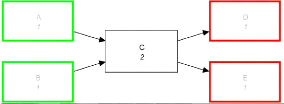
Figure 2.13: Process Model of the example log
2.4.4 Genetic algorithm plug-in
It uses genetic algorithms to calculate the best possible
process model for a log. A fitness measure that evaluates how well the
individual can reproduce the behavior present in the input log is assigned to
every individual. In this context, individuals are possible process models.
Candidate individuals are generated using genetic operators like crossover and
mutation and then the fittest are selected. This algorithm was proposed to deal
with some issues involving the logs, like noise and incompleteness [36].
To illustrate what kind of graph is presented by this tool, we
used the example show in table 2.1, and used the ProM implementation of this
algorithm to come to the result shown in Figure: 2.14
42
Process Mining Tools
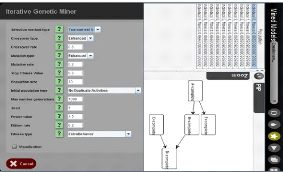
Figure 2.14: Process Model of the example log with genetic
miner.
Some of the organizational perspective tools available in ProM
that approach this subject are:
2.4.5 Social Network miner plug-in
This plug-in reads a process log and generates social networks
(Figure 2.15) that can be used as a starting point for SNA (Social Network
Analysis). Several techniques can be applied to analyze the social networks,
e.g., find interaction patterns, evaluate the role of an individual in an
organization, etc. The main idea of the social network miner is to monitor how
individual process instances are routed between actors. It exist five kinds of
metrics to generate social networks, They are 'handover of work',
'subcontracting', 'working together', 'similar task', and 'reassignment' (for
more information see [37]).
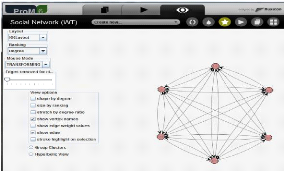
Figure 2.15: Descovering social networks by ProM.
43
Process Mining Tools
2.4.6 Organizational Miner plug-in
Organizational mining focuses on the organizational
perspectives such as organizational models. It works at a higher level of
abstraction than the previous techniques. While the Social Network Miner works
at the level of the individual, the Organizational Miner technique works at the
level of teams, groups or departments.
2.4.7 Staff Assignment Miner plug-in
Staff assignment mining aims at defining who is allowed to do
which tasks. Its techniques mine and compare the 'real' staff assignment rules
with the staff assignment rules defined for the underlying process afterwards.
Based on this comparison, possible deviations between existing and mined staff
assignment rules can be automatically detected [25].
There are other kind of mining tools which deal with the data
perspective and which use not only the information about activities and events,
but they also make use of additional data attributes present in logs. An
example of such miners is the Decision Miner.
2.4.8 Decision Miner plug-in
Decision Miner analyzes how data attributes of process
instances or activities (such as timestamps or performance indicators)
influence the routing of a process instance. To do so, the Decision Miner
analyzes every decision point in the process model and if possible links it to
the properties of individual cases (process instances) or activities [4].
There are also some plug-ins that deal with less structured
processes:
2.4.9 Fuzzy Miner plug-in
The process models of less structured processes, tend to be
very confusing and hard to read (usually referred to as spaghetti models). This
tool aims to emphasize graphically the most relevant behavior, by calculating
the relevance of activities and their relations (see Figure2.3). To achieve
this, two metrics are used [40]:
1. Significance: Measures the level of interest to
an events (for example by calculating their frequency on the log),
2. Correlation Determines how closely related two
events that follow each other are, so that events highly related can be
aggregated.
44
Process Mining Tools
In the context of process mining, using a mining plug-in on a
log to obtain a model of some sort is typically the first stage. But, it may be
not sufficient. The resulting model may need some additional analysis or needs
to be converted into another format. For this purpose, ProM contains analysis
and conversion plug-ins, as shown in the remainder of this Chapter.
2.5 Analysis Tools
Even if process mining is very concluding step, the resulted
process models still typically static structures that compactly describe
information that was generated from the log. These models however are not the
final result. Instead, there may be more interesting results by answering
questions about the obtained results, i.e there may be questions that can only
be answered by analyzing the results of mining in a larger context. It exist
analysis plug-ins that serve this purpose, i.e. they take a number of models or
other structures as input and then perform analysis techniques that relate to
the question under investigation. Next we present only a few of those that we
consider more relevant:
2.5.1 Conformance checker
Conformance checker [29] analyzes the gap between a model and
the real world, detecting violations (bad executions of a process) and ensuring
transparency (the model might be outdated). The conformance checker supports
analysis of the (1) Fitness, (2) Precision (or Behavioral
Appropriateness), and (3) Structure (or Structural Appropriateness)
dimension( as show in Section 1.4.1.
Fitness The token-based fitness measure f relates the amount
of missing tokens with the amount of consumed ones and the amount of remaining
tokens with the amount of produced ones. If the log can be replayed correctly,
i.e., there were no tokens missing nor remaining, it evaluates to 1. If every
produced and consumed token is remaining or missing the metric evaluates to 0
(Figure 2.16). There are several options to enhance the visualization of the
process model (Token Counter, Failed Tasks, Remaining Tasks, Path Coverage,
Passed Edges).
45
Process Mining Tools
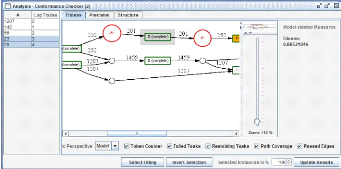
Figure 2.16: Model view shows places in the model where
problems occurred during the log replay.
Behavioral Appropriateness Behavioral
appropriateness consist on analyzing if the process model allow or not for more
behavior than that recorded in the log (Figure 2.17). This "extra behavior"
detection is also called precision dimension, i.e., the precision is 100% if
the model "precisely" allows for the behavior observed in the log. This way
can, for instance, to discover alternative branches that were never used when
executing the process.
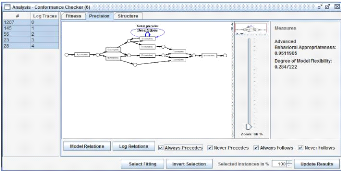
Figure 2.17: Analysis of the precision of a model allows to
detect overgeneral parts.
Structural Appropriateness Structure is the
syntactic ways by which behavior (i.e., the semantics) can be specified, using
the vocabulary of the modeling language (for example, routing nodes such as AND
or XOR) in a process model (Figure 2.18). However, it is not the only way,
there are several other syntactic ways to express the same behavior, and there
may be "preferred" and "less suitable" representations. Clearly, it highly
depends on the formalism of the process modeling and is difficult
46
Process Mining Tools
to assess in an objective way. However, it is possible to
formulate and evaluate certain "design guidelines", such as calling for a
minimal number of duplicate tasks in the model.
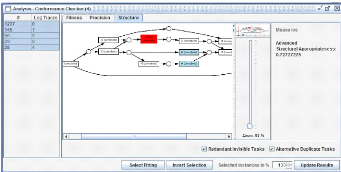
Figure 2.18: Structural analysis detects duplicate task that list
alternative behavior and redundant tasks.
2.5.2 Woflan plug-in ( A Petri-net-based Workflow Analyzer)
Woflan (WOrkFLow ANalyzer) [42], analysis a Petri Nets based
definitions of workflow process (Figure 2.19). It has been designed to analyze
the correctness of a workflow. Woflan it consists of three main parts: parser,
analysis routines, user interface.

Figure 2.19: The correctness of a model using Woflan tool.
2.5.3 Performance analysis
Drives performance information about a process using the
timestamps stored in logs and a Petri Net. After that, the performance data is
visually represented in the form of a
47
Process Mining Tools
Petri Net (Figure 2.20).
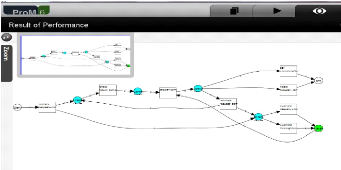
Figure 2.20: Scheenshot of the analysis plug-in Performance
Analysis with Petri net.
2.5.4 LTL checker
Checks whether a log satisfies some Linear Temporal Logic
(LTL) formula (Figure 2.21). For instance, it can check if a given activity is
executed by the person that should be executing it or check activities
ordering, like, whether an activity A that has to be executed after
B are indeed always executed following the right order [41].
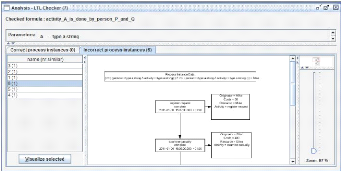
Figure 2.21: Scheenshot of the analysis plug-in LTL Checker
Plugin (Example raining) [41]
In this section, we have presented several analysis plug-ins
for different purposes. The overview given in this section is far from
exhaustive. Although many analysis techniques have been developed for specific
purposes. We have seen that ProM allows the user to use many more analysis
techniques. It has a particular power which is the fact that formalisms can be
converted back and forward using conversion plug-ins.
48
Process Mining Tools
2.6 Conversion Plug-ins
To translate of one formalism into another, ProM provides some
conversion plug-ins. So, with ProM it is really easy to convert one model into
another model if one is willing to accept some loss of information or
precision.
2.6.1 BPMN to Petri-Net
The BPMN to Petri-Net translation is implemented in the
context of ProM as a plug-in named 'BPMN to Petri Net conversion
plug-in'. Translations from BPMN to Petri Nets can be very useful because
they are applicable in most practical cases. The figure 2.23 shows the result
of the conversion of the BPMN illustrated in Figure 2.22.
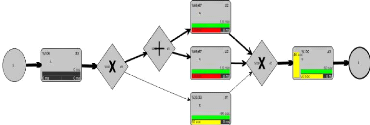
Figure 2.22: BPMN example
The Figure 2.23 shows a labelled Petri Net, where the
transitions relating to functions are labelled with the function labels and the
transitions relating to connectors are labelled with ô and shown in
black. Furthermore, in the background, the conversion plug-in used a special
set of reduction rules to remove as many of those ô-labelled transitions
as possible, without changing the behaviour. However, the resulting Petri Net
still shows a lot of ô-labelled transitions. These transitions correspond
to the OR-split and the OR-join.
49
Process Mining Tools
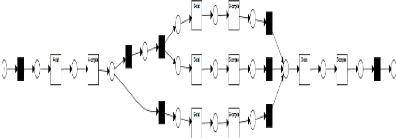
Figure 2.23: Petri net translation of the BPMN in Figure
2.22
2.6.2 Petri Net to Yawl Model
The figure 2.24 shows a YAWL model as a result from converting
the Petri Net. In this case, the conversion plug-in is able to remove all
routers (i.e., the invisible transitions) from the resulting process model.
Removing the invisible transitions introduces an OR-join and an OR-split,
moreover conditions (corresponding to Petri Net places) are only introduced
when needed. Clearly, such as smart translation is far from trivial.
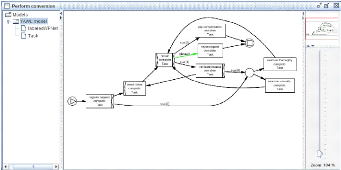
Figure 2.24: The mined review process model converted to a YAWL
model.
2.6.3 Petri Net into WF-Net
It is also possible to convert Petri Net into WF-Net. There is
a specific plug-in for that (Petri net into WF-net plug-in). In the case a
Petri Net contains multiple source places, then a new source places will be
added. Also, for every old source place a transition will be added that can
move the token from the new source place to the old one [40].
50
Process Mining Tools
2.6.4 YAWL model into EPC
An other conversion plug-in serves to convert YAWL models into
EPC (YAWLToEPC). It follows the following steps:
1. Find the root decomposition of the YAWL model,
2. Convert every ordinary YAWL condition into a chain of two
EPC (XOR) connectors. The first connector will be a join, the second a
split,
3. Converts every YAWL input condition into a chain of a
start EPC event, a dummy EPC function, and an EPC (XOR-split) connector,
4. Converts every YAWL output condition into a chain of an
EPC (XOR-join) connector and a final EPC event,
5. Converts every YAWL task into a chain of an EPC (join)
connector, a dummy EPC event, an EPC function, and an EPC (split) connector.
The type of both connectors depends on the input/output behavior of the YAWL
task. If the YAWL task refers to another YAWL decomposition, this decomposition
is converted as well (steps 2 to 6), although no start or end events (see steps
3 and 4) will be generated for this decomposition.
6. Converts every YAWL edge into a corresponding EPC edge,
7. Reduces as many EPC connectors as possible,
8. Removes any source/sink EPC connectors.
It exist many other conversion plug-ins for ProM framework,
such as: Petri Net to Heuristic Net, Petri Net to Epc,...etc. This
characteristic makes ProM one of the most useful tool for process mining.
51
Process Mining Tools
2.7 Conclusion
In this chapter we have introduced some important concepts
related to process mining tools. We have presented the main characteristics and
plug-ins of one of the most popular mining framework, which is ProM. We have
seen that ProM is very useful and provides several advantages. The continuous
growth of ProM is due to the importance that process mining has gained in
recent years, resulting in numerous research performed by people around the
world.
The next chapter will be devoted to the comparison between
different mining techniques following different criteria.
52
Chapter3
Comparison and analysis of process
mining algorithms
3.1 Introduction
There are many process mining algorithms with different
theoretical foundations and aims, raising the question of how to choose the
best for a particular situation. This is a problem, for both, businesses using
process mining and for researchers evaluating new developments. There is a need
for methods for objectively comparing process mining algorithms against known
characteristics of business process models and logs, in terms of what can be
re-discovered and how much data is required to do so.
In the previous chapters we have seen different concepts
related to business process and process mining, different evaluation criteria
and metrics and then we have presented some process mining tools.
In this chapter we use the ProM framework (presented in
chapter 2) to objectively analyze and compare process mining algorithms against
a known ground truth. The analysis in this chapter concerns three mining
algorithms, namely: the Alpha algorithm, Heuristic algorithm and Genetic
algorithm, according to the metrics presented in the chapter 1.
3.2 Problem Description
We have seen that it exists a plenty of approaches and
paradigms to process mining. There are approaches with local methods which look
at local relations between activities
53
Comparison and analysis of process mining
algorithms
in logs ( á, á+, Heuristics Miner),
and global approaches which build and refine a model based on the whole log
(Genetic Mining, Fuzzy Miner [40]).
In general, each algorithm has its one specialisms, e.g. the
Heuristics Miner uses frequencies and parametrization to handle noise,
á- algorithm is able to mine models that adhere to the restrictions of
Structured Workflow Nets (SWF-nets) [35], but not mine implicit dependencies or
handle noisy logs well and Genetic miner can mine complex and noisy logs, but
it is resource intensive.
In some considerations, having a plenty of algorithms can be
see as advantage, as it offers many use possibilities, but from another point
of view, it also constitutes a problem of making the choice which algorithm to
use. There is a need for a method to objectively compare process mining
algorithms, to enable informed choice of which to use in a situation. Which
algorithms work "best", in what circumstances? Which results are the "best",
and can this be quantified in terms of accuracy or confidence [27].
3.3 Comparison and analysis
For the experimentation and to make comparison between the
three algorithms (Alpha, Genetic and Heuristic), we have chosen to use an
existing real-life event log. In this section we will run different tests on
events log using the ProM framework. For each test, one small log file is mined
with one algorithm and the resulted process model (converted, and) exported as
a Petri Net. Next, we run the Conformance Checker plug-in [29] to measure the
mined model against the underlying process described by event logs. The
collected results can then be analyzed. Data recorded include each algorithm's
specific reports, such as the characteristics of the discovered Petri Net, plus
the Conformance Checker's assessment of the model's Fitness, Behavioral
Appropriateness (under-fitting) and Structural Appropriateness (over-fitting
and generalization), Structural precision (and recall) and Behavioral precision
(and recall).
3.3.1 Log description
We have chosen two main event logs for the experimentation and
comparison task. The first one was provided in the Fourth International
Business Process Intelligence Challenge (BPIC'14) as a challenge for the
participants, to analyze its data using whatever techniques available. It
reflect an activity undertaken by the Rabobank Group ICT (Rabobank Nederland)
and it contains a log of the activity of the various incidents that may arise
during the change of new software releases.
54
Comparison and analysis of process mining
algorithms
The processes within Rabobank ICT 3.1 revolve around the
following service desk processes: Interaction Management, Incident Management,
Change Management.

Figure 3.1: The processes within Rabobank ICT
The Table 3.1 shows an extract of the event log that we use :
|
DateStamp
|
Incident-Activity-Number
|
Incident-Activity-Type
|
Assignment-Group
|
KM-number
|
|
07/01/2013 08:17
|
001A3689763
|
Reassignment
|
TEAM0001
|
KM0000553
|
|
04/11/2013 13:41
|
001A5852941
|
Reassignment
|
TEAM0002
|
KM0000553
|
|
04/11/2013 13:41
|
001A5852943
|
Update from customer
|
TEAM0002
|
KM0000553
|
|
04/11/2013 12:09
|
001A5849980
|
Operator Update
|
TEAM0003
|
KM0000553
|
|
04/11/2013 12:09
|
001A5849978
|
Assignment
|
TEAM0003
|
KM0000553
|
|
04/11/2013 12:09
|
001A5849979
|
Assignment
|
TEAM0002
|
KM0000553
|
|
04/11/2013 12:09
|
001A5852942
|
Closed
|
TEAM0003
|
KM0000553
|
|
04/11/2013 12:09
|
001A5852172
|
Caused By CI
|
TEAM0003
|
KM0000553
|
|
04/11/2013 12:09
|
001A5852173
|
Reassignment
|
TEAM0003
|
KM0000553
|
|
25/09/2013 08:27
|
001A5544096
|
Operator Update
|
TEAM0003
|
KM0000553
|
|
03/06/2013 11:15
|
001A4725475
|
Update
|
TEAM9999
|
KM0000611
|
Table 3.1: Extract of the event log
The second event log is provided in the chapter 5 in [35], it
contains instances of some reimbursement process. The table 3.2 shows a
fragment of the log corresponding to the handling of requests for compensation.
Each line presents one event. The events are already grouped per case. Case 1
has five associated events. The first event of Case 1 is the execution of
activity register request by Pete on December 30th, 2010. There is different
properties attributes for each event, like date and timestamp, ressource or
cost.
55
Comparison and analysis of process mining
algorithms
|
Case id
|
Event id
|
Timestamp
|
Activity
|
Resource
|
Cost
|
|
1
|
35654423
|
30-12-2010:11.02
|
Register request
|
Pete
|
50
|
|
35654424
|
31-12-2010:10.06
|
Examine thoroughly
|
Sue
|
400
|
|
35654425
|
05-01-2011:15.12
|
Check ticket
|
Mike
|
100
|
|
35654426
|
06-01-2011:11.18
|
Decide
|
Sara
|
200
|
|
35654427
|
07-01-2011:14.24
|
Reject request
|
Pete
|
200
|
|
2
|
35654483
|
30-12-2010:11.32
|
Register request
|
Mike
|
50
|
|
35654485
|
30-12-2010:12.12
|
Check ticket
|
Mike
|
100
|
|
35654487
|
30-12-2010:14.16
|
Examine casually
|
Pete
|
400
|
|
35654488
|
05-01-2011:11.22
|
Decide
|
Sara
|
200
|
|
35654489
|
08-01-2011:12.05
|
Pay compensation
|
Ellen
|
200
|
|
3
|
35654521
|
30-12-2010:14.32
|
Register request
|
Pete
|
50
|
|
35654522
|
30-12-2010:15.06
|
Examine casually
|
Mike
|
400
|
|
35654524
|
30-12-2010:16.34
|
Check ticket
|
Ellen
|
100
|
|
35654525
|
06-01-2011:09.18
|
Decide
|
Sara
|
200
|
|
35654526
|
06-01-2011:12.18
|
Reinitiate request
|
Sara
|
200
|
|
35654527
|
06-01-2011:13.06
|
Examine thoroughly
|
Sean
|
400
|
|
35654530
|
08-01-2011:11.43
|
Check ticket
|
Pete
|
100
|
|
35654531
|
09-01-2011:09.55
|
Decide
|
Sara
|
200
|
|
35654533
|
15-01-2011:10.45
|
Pay compensation
|
Ellen
|
200
|
Table 3.2: A fragment of the second event log: each line
corresponds to an event.
3.3.2 Experimentation
This part is devoted to do some experimentation's to compare
results of using different algorithms for process mining. To do that, we have
used a real-life event loge, which reflect an activity undertaken by the
Rabobank Group ICT (Rabobank Nederland) and reimbursement. Mining was carried
out using the á-Miner, Heuristics Miner (HM), Genetic Miner (GM)
algorithms, using the ProM framework. We have chosen these three algorithms
because they are fundamental algorithms, commonly used, implemented in the ProM
framework, and represent significantly different approaches to process mining.
We perform experimentation according to different kind of metrics, which
are:
1. Fitness
2. Precision and Generality
3. Precision and Recall
On bellow, we expose the obtained results for each metric.
3.3.2.1 Fitness
To calculate the fitness, we have used the event logs with
different traces number. We start by 10 traces and we increase the number by 2
traces for each time, until 28 traces.
56
Comparison and analysis of process mining
algorithms
We have experimented the three algorithms, mentioned above,
under two scenarios: at first we used the file as it is, and the second
scenario is after being filtered using the plug-in filter "filter log using
simple heuristics (see section 2.3). Figure 3.2 shows the results (In the form
of a graph) before filtering.
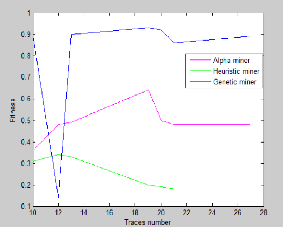
Figure 3.2: Fitness against the number of traces before
filtering
We can see in the figure 3.2 that the Heuristic Miner recorded
a slight growth in the fitness against a number of traces equal to 12, after
that, it began to decline and then stabilize around 0.2 fitness against a
number of traces higher than 22. This result for the Heuristic Miner, can be
interpreted by the fact that the event logs contain a lot of noise, and that
this algorithm takes into account the frequent traces which is not the case
with this log file (most traces are not frequent).
Also for the alpha algorithm, the graph begins with a growth
in the fitness values against a number of traces in the interval [10, 19], but
it recorded a sharp fall thereafter, and stabilizes on the value 0.5 for
fitness, against a number of traces higher than 21. The result of Alpha Miner
can be interpreted by the fact â€â€that this algorithm
does not take into account the noise, it only considers the relationships
between activities.
The last algorithm, which is the Genetic Miner, begins
directly with a decrease but grows after 12 traces and stabilizes around 0.9
for fitness with a slight increase after a number greater than 20 traces. This
can be interpreted by the fact that Genetic Miner do not only uses the method
of Heuristic Miner to consider noise, but also duplicate tasks.
57
Comparison and analysis of process mining
algorithms
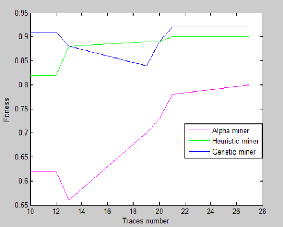
Figure 3.3: Fitness against the number of traces after
filtering
The figure 3.3 shows the obtained results after filtering
events logs. It is clearly visible that there is a marked improvement for the
three algorithms. We can see that both algorithms Genetic Miner and Alpha
miner, after a slight decline, they recorded growth when the number of traces
is higher than 13 traces and they stabilize around 0.9 and 0.8 for fitness,
respectively. Concerning the Heuristic miner algorithm, the graph is growing
and stabilizes at 0.9 fitness when the number of traces is higher than 21. So
after filtering, the best results are achieved by Heuristic Miner and Genetic
Miner algorithms. This can be explained by the fact that the filter is used to
filter and keep only the events that we want and that are relevant, which
contribute to obtain much more similar traces. It is also worth to note that
the best value of the fitness is registered by the Genetic Miner algorithm.
3.3.2.2 Precision and Generality
Precision and generality are very common and important aspects
of comparison between models in many fields of research in computer science.
Researchers are still trying to find a good compromise between these capital
characteristics. Due to their nature, it is important to find a good balance
between both.
In process discovery, precision and generality are a major
challenge. Although models should be precise, generalizing beyond observed
behavior is also a necessity. So process discovery algorithms should be able to
balance between underfitting(overly general models) and overfitting (overly
precise models). Therefore, superior precision and generality
58
Comparison and analysis of process mining
algorithms
metrics should be at hand.
There are two kinds of measures which can be used to quantify
precision and generality: Behavioral Appropriateness and Structural
Appropriateness.
Behavioral Appropriateness
Behavioral Appropriateness consist on analysis and detection
of "Extrat behavior" of the model. A Process model may allow for more behavior
than that recorded in the log. There is two metrics for this measure :
· Simple behavioral appropriateness:
(see section 2.5.1): measure saB based on the mean number of enabled
transitions during log replay (the greater the value the less behavior is
allowed by the process model and the more precisely the behavior observed in
the log is captured). Note that this metric should only be used as a
comparative means for models without alternative duplicate tasks.
· Advanced Behavioral Appropriateness:
aaB allows to compare the behavior that is specified by the model with
the behavior that is actually needed to describe the behavior in the event log.
Therefore, this metric makes use of an analysis of "follows" and "precedes"
relations, both in the model and the event log. Comparing the variability of
these relations allows the definition of a precision metric that penalizes
extra behavior.
Structural Appropriateness
In a process model, there are several syntactic ways to
express the same behavior. Structure is the syntactic means by which behavior
can be specified, using the vocabulary of the modeling language. Therefore,
having several ways implies different characteristics which may be "preferred"
(for example, easier to understand) and "less suitable" representations. To
quantify the degree of structural appropriateness, the only currently available
model-log metrics are:
· Simple Structural appropriateness:
saS is a simple measure based on the size of the graph (the greater
the value the more compact is the model). Note that this metric should only be
used as a comparative means for models allowing for the same amount of
behavior.
· Advanced structural appropriateness :
aaS is a generality metric that evaluates two specific design guidelines for
expressing behavioral patterns. This measure
Comparison and analysis of process mining
algorithms
will punish for both alternative duplicate tasks and redundant
invisible tasks. Note that these guidelines are definitely not the only
behavioral preferences of control-flow models. However, aaS is the only metric
that quantifies generality in some way. Ideally, a process model does not
contain redundant invisible tasks nor alternative duplicate tasks. Accordingly,
this measure will punish for models that simply enumerate all traces in the
event log and for models that entail too much irrelevant invisible tasks.
In this part we investigate the above metrics. For that, we
use two examples from real-life datasets (The first one contains instances of
some reimbursement process (We took the file used in the chapter 5 in [35]) and
the second file contains the detail incident activity of the Rabobank ICT
(which we already used for measuring fitness)). Short names are used in the
first dataset: a = register request, b = examine thoroughly, c = examine
casually, d = check ticket, e = decide, f = reinitiate request, g = pay
compensation, and h = reject request.
The Figures (3.4, 3.5, 3.6) show the obtained models according
to the used algorithms (Alpha, Genetic and Heuristic respectively).

Figure 3.4: Mined model by Alpha algorithm
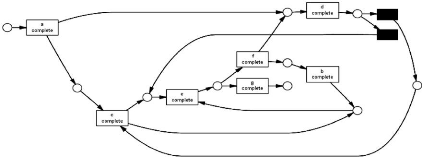
59
Figure 3.5: Mined model by Genetic algorithm
Comparison and analysis of process mining
algorithms

Figure 3.6: Mined model by Heuristic miner
The table 3.3 shows the metrics values for the first example. We
note that both Alpha and Heuristic algorithms provide the same and a good
structural appropriateness, while Genetic produce models with a poor structural
appropriateness.
On the other hand, Alpha and Heuristic algorithm produces a model
with reasonable behavioral appropriateness, while Genetic algorithm produce
model with excellent behavioral appropriateness.
|
Alpha
|
Heuristic
|
Genetic
|
|
Structural Appropriateness
|
0.6
|
0.6
|
0.15
|
|
Behavioral Appropriateness
|
0.8
|
0.8
|
0.97
|
Table 3.3: Conformance checker between the first example and its
mined models
In the second example, we have considered one trace with the
ID = IM0047050 from the incident detail activity (the firs event log) dataset.
The figures (3.7, 3.8, 3.9) show the obtained models after using three
algorithms.

60
Figure 3.7: Mined model by Alpha algorithm case 2
61
Comparison and analysis of process mining
algorithms
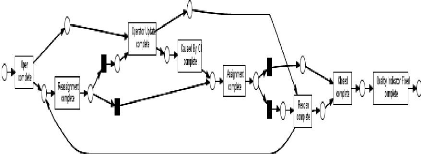
Figure 3.8: Mined model by Genetic algorithm case 2

Figure 3.9: Mined model by Heuristic miner case 2
The table 3.4 shows that Alpha and Heuristic algorithms
produce models with excellent behavioral appropriateness. While Genetic
algorithm produces a model with reasonably good structural similarity. All of
three algorithms produce models with excellent structural appropriateness.
|
Alpha
|
Heuristic
|
Genetic
|
|
Structural Appropriateness
|
1
|
1
|
1
|
|
Behavioral Appropriateness
|
0.95
|
0.94
|
0.79
|
Table 3.4: Conformance checker between IM0047050 case and its
mined models
The above two examples (based on real-life datasets) have
illustrated that different process mining algorithms perform differently on
different models. As a result, researchers need to benchmark different process
mining algorithms to select appropriate algorithms for their models, but this
can be computationally expensive and take a long time.
3.3.2.3 Precision and Recall
Precision and Recall are the basic measures used in evaluating
search strategies. In the first case, we are interested in two metrics, which
are the structural precision and the
Comparison and analysis of process mining
algorithms
structural recall. In the second case we are interested in the
behavioral precision and the behavioral recall.
Structural precision and recall: Structural
precision and structural recall are based on the causality relations of the
mined and original models, and were adapted from the precision and recall
metrics presented in [22]. These metrics basically work by checking how many
causality relations the mined and the original model have in common. The more
causality relations the two models have in common, the more similar their
structures are. The structural precision assesses how many causality relations
the mined model has that are not in the original model. The structural recall
works the other way around. Note that the structural similarity performed by
these metrics does not consider the semantics of the split/join points[3].
Behavioral precision and recall: Behavioral
precision and behavioral recall are based on the parsing of an event log by the
mined model and by the original model. The behavioral precision checks how much
behavior is allowed by the mined model that is not by the original model. The
behavioral recall checks for the opposite. Additionally, both metrics take into
account how often a trace occurs in the log [3].
To test these metrics we used the example of instances of some
reimbursement process used in the book [35]. We took the original model with 8
different events logs. In the following, we present the obtained results.
The figure 3.10 illustrate the obtained results for precision.
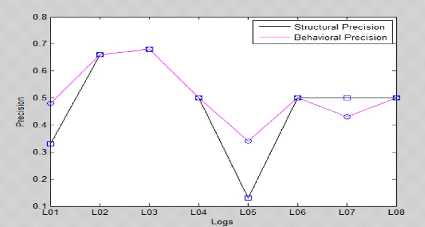
Figure 3.10: Average Structural precision and Behavioral
precision values
62
63
Comparison and analysis of process mining
algorithms
The figure 3.11 illustrate the obtained results for recall.
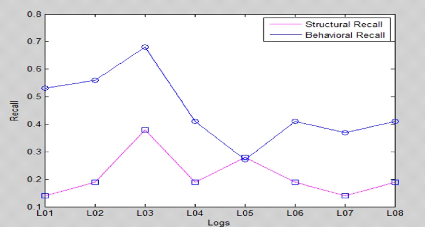
Figure 3.11: Average Structural recall and Behavioral recall
values
All these four metrics are complementary when assessing the
quality of a mined model. Moreover, the application of these metrics is not
limited to the evaluation of the different algorithms. They can be applied to
another settings where models need to be compared.
3.4 Conclusion
In this section we have presented the seven metrics that are
used to analyze the results of the experiments: the fitness, precision and
generalization, the behavioral precision (BP), the behavioral recall (BR),the
structural precision (SP) and the structural recall (SR). The fitness addresses
the ability of a model to capture all the recorded behavior in the event log.
Precision and generalization enables the user to control the balance between
"overfitting" and "underfitting". The BP and BR measures how precise the mined
model is. The SP and SR express if the mined model has an overly complex
structure or not. These metrics are complementary and should be considered
together during the experiments analysis.
64
Chapter4
Proposition
4.1 Introduction
Process discovery aims to reconstruct process models from
execution logs. Specifically: given a log, each of the cases (i.e. execution
traces) is analyzed, eventually producing a (Petri net) model of the process.
Existing techniques perform well on structured processes, but still have
problems discovering and visualizing less structured ones. In reality, there is
a lot of diversity leading to complex models that are difficult to interpret.
Trace clustering is one of very promising technique to best mining results.
Trace clustering approach aims at splitting the event log into homogeneous
subsets and for each subset a process model is created.
The aims of our work in this chapter is to provide a solution
that will improve traces clustering compared to the existing techniques. We
rely on the work already proposed by Song et al [32], where we define another
distance measure between two cases. Our contribution is the use of Boolean
logic through the »XOR» and »AND»
function to calculate the distance between two traces and new clusters
centres.
4.2 Proposition description
For well-structured processes, e.g. workflows, the discovery
aspect of process mining has limited appeal, since it is bound to confirm the
prescribed characteristics of the process. There are, however inherent problems
of applying process mining to flexible environments. Since these environments
typically allow for a wide spectrum of potential behavior, the analysis results
are equally unstructured. The typical problems observed in resulting process
models are an overwhelming number of task nodes, and equally large
65
Proposition
numbers of relations, resulting in the stereotypical
"spaghetti models". One dominant factor contributing to unstructured mining
results is diversity of an event log, i.e. single cases differ significantly
from one another. It is, in such cases, a valid assumption that there are a
number of tacit process variants hidden within one event log, each
significantly more structured than the complete process.
The problem with diversity, i.e. that a set of cases are
structured very differently, obviously grows with the number of cases being
analyzed. Thus, one solution to this problem is to reduce the number of cases
which are analyzed at once. Tacit processes will usually not be explicitly
known, i.e. there is no available knowledge on how to partition the set of
cases. One can, however measure the similarity of cases and use this
information to divide the set of cases into more homogeneous subsets. The
authors in Song et al [32]. have got the idea to use the conventional
clustering methods. They were the first who applied the methods of clustering
in the mining process field, such that (K-means, Quality Threshold,
agglomerative Hierarchical Self-Organizing Map (SOM)).
Autors in[32] points correspond to cases, i.e., process
instances that left a trace in the log, each case is characterized by a defined
set of items, i.e., specific features which can be extracted from the
corresponding trace. Items for comparing traces are organized in trace
profiles, each addressing a specific perspective of the log. Based on a set of
profiles, each measuring a number of features for each case from a specific
perspective. Based on these feature matrices, a number of distance metrics can
be applied to compute the relative distance between any two cases in the log.
To check the accuracy of the generated model, we can perform a conformance
check. In [26] two types of metrics are proposed: (1) fitness and (2)
appropriateness.
For our proposition to trace clustering, we built our approach
using a part of the work of Song et al.[32] by adopting their definition of
traces profiles but with different distance measure and cluster center
calculation. We define another way to calculate the distance between one case
and a cluster center, we use the Boolean logical "XOR" to calculate the
distance between two points and the AND logical operator to calculate new
centers of the clusters. The figure 4.1 shows the main steps in our traces
clustering approach.
66
Proposition
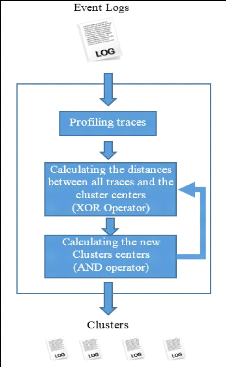
Figure 4.1: Our clustering approach overview
4.2.1 Trace Profiles
In the authors [32] approach case is characterized by a
defined set of items, i.e., specific features which can be extracted from the
corresponding trace. Items for comparing traces are organized in trace
profiles, each addressing a specific perspective of the log.
Every clustering algorithm attempts to group sets of similar
points, whereas for trace clustering, the points to be clustered are log
traces. Thus, in order to cluster traces in a meaningful way, we first have to
establish what makes two traces similar. Event logs in the MXML format contain
a large amount of structured information. Some of this information is explicit
(e.g., names of events), however there is also derived information, e.g. the
number of events within a trace.
wIn our approach, traces are characterized by profiles, where
a profile is a vector Profile_V ector composed of n
items (hich support binary values) as follow :
Profile_Vectori = (a1,
a2, ..., an).
67
Proposition
Where aj=1..n are binary values
representing if an activity aj is present in the trace or not. 1 means
the activity occur at least once, and 0 means that the activity does not occur
in the trace. These resulting vectors will be used to calculate the distance
between traces and to calculate the clusters centers. A cluster center is
represented also by a Trace profile.
4.2.2 XOR Operator
The XOR function, often called eXclusive OR or exclusive
disjunction is a logical operator of Boolean algebra. The inputs to a binary
XOR operation can only be 0 or 1 and the result can only be 0 or 1.
This operator is used in electronics, computer science, and
also in cryptography because of its interesting properties. It will always
produce a 1 output if either of its inputs is 1 and will produce a 0 output if
both of its inputs are 0 or 1.
We use XOR, because as it is an "exclusive OR", it
only returns a "true" value (1) if the two values are exclusive, i.e. they are
both different. So, applying XOR between two profiles will provide us
a serie of 1 for each two different items of the vectors profiles. This will
serve as a mean to calculate the difference degree of tow profiles.
If we consider two traces profiles A and B
and their vector items, the Table 4.1 shows the fourth possibles case when
applying XOR between the binary values of the profiles vectors and
their meanings.
|
Item (Activity)
|
Ai
|
Bj
|
Ai XOR Bj
|
interpretation for our approach
|
|
1
|
0
|
0
|
0
|
the two traces have no occurrence of the activity (The traces
are similar concerning the activity 1).
|
|
2
|
0
|
1
|
1
|
one of the two traces have at least one occurrence of the
activity (The traces are mutually exclusive concerning the activity 2
|
|
3
|
1
|
0
|
1
|
one of the two traces have at least one occurrence of the
activity (The traces are mutually exclusive concerning the activity 3
|
|
4
|
1
|
1
|
0
|
the two traces have at less one occurrence of the activity
(The traces are similar concerning the activity 4).
|
Table 4.1: Interpretation of XOR results
4.2.3 AND Operator
The Logical AND is an operator on two logical values
that produces a value of true if and only if both of its operands are true. We
apply the logical AND on the values of two
68
Proposition
Traces profiles among all the traces in the same cluster to built
a new cluster center. The table 4.2 show how we use the logical AND
between two items of a ProfileV ector.
|
Item (Activity)
|
Ai
|
Bj
|
Ai AND Bj
|
interpretation for our approach
|
|
1
|
0
|
0
|
0
|
the two traces have nothing in common concerning the activity
1.
|
|
2
|
0
|
1
|
0
|
the two traces have nothing in common concerning the activity
2.
|
|
3
|
1
|
0
|
0
|
the two traces have nothing in common concerning the activity
3.
|
|
4
|
1
|
1
|
1
|
the two traces have occurrences of the activity 4, so they can
be considered similar.
|
Table 4.2: Interpretation of AND results
The process of applying the logical AND among a set
of traces profiles provide at the end a vector in with all the items at 1
represent the activities which occur in all the traces in the set.
4.2.4 Clustering Algorithm
As used in the [32], we use the K-means clustering algorithm,
because it is the most commonly used in practice among partitioning methods,
which constructs k clusters by dividing the data into k
groups. The steps below, illustrate the main steps in our clustering
approach.
1. Define a profile for each case x (1 if the activity exists, 0
otherwise);
2. Define one or more centers (the center is defined as a
kind of filter (ie: define the activities we want to see in each cluster (1 if
there's an activity we wish to see, otherwise 0);
3. Calculate the distance between each point (each case) and
each center (the distance is defined as an XOR operator);
4. Based on the distance, gather all traces that have a
minimum distance from to the center or centers;
5. Calculate the new center for each cluster (which is
defined as a LOGICAL AND between all traces in the same cluster);
6. Repeat step (3 to 5), until we have a stable cluster
configuration;
7. For each cluster, verify the distance of each point from
to the cluster, remove the distance exceeds 2.
69
Proposition
4.2.4.1 Distance Measure
To calculate the distance between a trace and each clusters we
use the XOR operator as follow:
let consider a traces profile a, and cluster center
profile b : a = (0001111) and
b = (1101011)
We have a XOR b = (1100100)
To calculate the distance between a and b,
we use this measure (D) = the sum of the resulted vector item
:
D = 1 + 1 + 0 + 0 + 1 + 0 + 0 = 3
The value 3 can be seen as the degree of difference
between the trace a and the cluster center b. In our
approach, we add a trace to the cluster with the minimum distance among the
distances to all the clusters centers. This can be interpreted as follow : we
add the trace to the cluster which represent a minimum differences with the
trace.
4.2.4.2 Calculate new clusters
In our approach, new clusters are built by applying logical
AND between traces in the same cluster. For instance, having two traces a
= (0001111) and c = (1101011) in the same cluster, the new
cluster ci will be :
ci = (0001011)
This can be interpreted as follow : we obtain a new cluster
center profile, in which, each item having the value 1 means that the
corresponding activity is occurred at least once in all the traces of the
cluster.
4.3 Running Examples
In this section we will apply our approach (Which we have
implemented using Java language) on different event logs and we will compare
obtained results against these of the approach of the Song et al [32],
which is already implemented in ProM 5.2.
The first event log (Shown in Table 4.3) we use is
that one used by song et al [32]. Each row refers to a single case and
is represented as a sequence of events. Events are represented by the case
identifier (denoted by the row, e.g., 1), activity identifier (first element,
e.g., A), and originator (second element, e.g., John).
70
Proposition
|
Case ID
|
log events
|
|
1
|
(A,John),(B,Mike),(D,Sue),(E,Pete),(F,Mike),(G,Jane),(I,Sue)
|
|
2
|
(A,John),(B,Fred),(C,John),(D,Clare),(E,Robert),(G,Mona),(I,Clare)
|
|
3
|
(A,John),(B,Pete),(D,Sue),(E,Mike),(F,Pete),(G,Jane),(I,Sue)
|
|
4
|
(A,John),(C,John),(B,Fred),(D,Clare),(H,Clare),(I,Clare)
|
|
5
|
(A,John),(C,John),(B,Robert),(D,Clare),(E,Fred),(G,Robert),(I,Clare)
|
|
6
|
(A,John),(B,Mike),(D,Sue),(H,Sue),(I,Sue)
|
Table 4.3: Example process logs (A: Receive a item and repair
request, B: Check the item,
C: Check the warranty, D: Notify the customer, E: Repair the
item, F: Test the repaired product, G: Issue payment, H: Send the cancellation
letter, I: Return the item)
Table 4.4 shows the result of profiling the example log from
table 4.3. Each row of the table corresponds to the profile vector of one trace
in the log. The Trace profile defines one item per type of activity (i.e.,
event name) found in the log. Measuring an activity item is performed by simply
counting if the activity has at least one occurrence in the trace.
|
Case ID
|
Trace Profile
|
|
A
|
B
|
C
|
D
|
E
|
F
|
G
|
H
|
I
|
|
1
|
1
|
1
|
0
|
1
|
1
|
1
|
1
|
0
|
1
|
|
2
|
1
|
1
|
1
|
1
|
1
|
0
|
1
|
0
|
1
|
|
3
|
1
|
1
|
0
|
1
|
1
|
1
|
1
|
0
|
1
|
|
4
|
1
|
1
|
1
|
1
|
0
|
0
|
0
|
1
|
1
|
|
5
|
1
|
1
|
1
|
1
|
1
|
0
|
1
|
1
|
0
|
|
6
|
1
|
1
|
0
|
1
|
0
|
0
|
0
|
1
|
1
|
Table 4.4: traces profiles for the example log from 4.3
The table 4.5 shows the metrics measures concerning the
obtained clusters for both approaches. At first, we have executed it for K = 2
(K represent the number of clusters) (song et al. approach and our approach
respectively). We see that we got a slightly better fitness.
|
Song et al
|
Our Approach
|
|
Cluster 1
|
Cluster 2
|
Cluster 1
|
Cluster 2
|
|
Traces
|
( T1,T3)
|
(T2, T4, T5, T6)
|
(T1, T2, T3)
|
(T1, T6)
|
|
Fitness
|
1
|
0.89
|
0.96
|
1.00
|
|
behavioral appropriateness
|
1
|
0.91
|
0.97
|
0.96
|
|
structural appropriateness
|
0.6
|
0.66
|
0.55
|
0.57
|
Table 4.5: Metrics values
Also for k = 3, we have practically the same results for the
cluster 1 and cluster 2 but we have a better fitness for the cluster 3. The
metrics values are shown in the table ( 4.6).
Proposition
|
|
Song et al
|
|
|
Our Approach
|
|
|
Cluster
(T3,T1)
|
1
|
Cluster (T5, T2)
|
2
|
Cluster (T4, T6)
|
3
|
Cluster (T3,T1)
|
1
|
Cluster (T2,T5)
|
2
|
Cluster (T4)
|
3
|
|
Fitness
|
1
|
|
0.87
|
|
0.91
|
|
1
|
|
0.87
|
|
1
|
|
|
behavioral appropriateness
|
1
|
|
0.96
|
|
0.90
|
|
0.96
|
|
0.95
|
|
1.00
|
|
|
structural appropriateness
|
0.6
|
|
0.66
|
|
0.50
|
|
0.6
|
|
0.66
|
|
0.60
|
|
Table 4.6: Metrics values
The second event log we use is already proposed by [41], which
contains instances of some reimbursement process. We apply the two approaches,
that of Song et al and ours. The event logs contains 1391 cases, as illustrated
in table 4.7.
|
Traces
|
Frequencies
|
|
acdeh
|
480
|
|
abdeg
|
210
|
|
adceh
|
200
|
|
abdeh
|
170
|
|
acdeg
|
130
|
|
adceg
|
95
|
|
adbeh
|
61
|
|
adbeg
|
45
|
Table 4.7: Event logs form [39]
For k = 2, we got a better fitness and appropriateness for the
metrics values (Table 4.9).
|
Song et al
|
Our Approach
|
|
Cluster 1
|
Cluster 2
|
Cluster 1
|
Cluster 2
|
|
Fitness
|
0.90
|
0.89
|
0.99
|
0.99
|
|
behavioral appropriateness
|
0.80
|
0.70
|
0.89
|
0.90
|
|
structural appropriateness
|
0.50
|
0.49
|
0.64
|
0.56
|
Table 4.8: Metrics values for the second event log
Also for k = 3, we have again better fitness for the all
clusters. The metrics values are shown in the table (4.9).
|
Song et al
|
Our Approach
|
|
Cluster 1
|
Cluster 2
|
Cluster 3
|
Cluster 1
|
Cluster 2
|
Cluster 3
|
|
Fitness
|
0.94
|
0.93
|
0.96
|
1
|
1
|
0.99
|
|
behavioral appropriateness
|
0.80
|
0.90
|
0.86
|
0.90
|
0.95
|
0.92
|
|
structural appropriateness
|
0.56
|
0.60
|
0.50
|
0.61
|
0.64
|
0.60
|
71
Table 4.9: Metrics values
72
Proposition
Once we compare the model with respect to the event log, we
come to compare the model with respect to another model. For this we take the
latest example as shown in table (Table 4.7).
We take the original model, and we compare the obtained models
by our approach and Song and al. For this we use Heuristic miner for modeling
and structural precision/recall, behavioral precision/recall for calculating
similarity between two models. We get the following results :
|
Song et al
|
Our Approach
|
|
Cluster 1
|
Cluster 2
|
Cluster 3
|
Cluster 1
|
Cluster 2
|
Cluster 3
|
|
behavioral precision
|
0.97
|
0.72
|
0.70
|
0.83
|
0.97
|
0.89
|
|
behavioral recall
|
0.90
|
0.57
|
0.85
|
0.77
|
0.90
|
0.81
|
|
structural precision
|
1.00
|
0.90
|
0.80
|
1.00
|
1.00
|
1.00
|
|
structural recall
|
0.70
|
0.52
|
0.50
|
0.50
|
0.64
|
0.64
|
Table 4.10: Metrics values
As shown in the table (4.10), we also have a better accuracy
than Song et al. This reflects that the obtained traces by our approach in each
cluster are much similar to each other.
4.4 Discussion
As shown in the results illustrated by the different tables in
this section, we obtain a slight improvement results with respect to these of
the song et al approach. Moreover, our approach is different from the approach
of Song at several levels which can contribute to the reduction of the number
of the Algorithm iterations and the time of execution. Below, we show the main
differences :
1. The consideration of a single parameter in the clustering
process, which is activities. In Song et al [32] approach, they consider
activities and originators.
2. In Song and al approach, the filter must be done before
clustering, in our approach, the filtering is done at the time of the
construction of clusters (filtering and construction of clusters are at the
same time)
The major drawback of our approach, is in the fact that it
does not take into account the loops.
73
Proposition
4.5 Conclusion
Since trace clustering operates on the event log level, it can
be used to improve the results of any process mining algorithm. In this chapter
we have presented our methodology for trace clustering, which can effectively
resolve diversity-related problems, by dividing the log into smaller, more
homogeneous subsets of traces. We have used the concept of trace profile
introduced by Song et al [32]. which is suitable way for characterizing and
comparing traces. Based on trace profile, we have proposed a new way to
calculate the distance between two cases and a new way to construct new
clusters. The obtained results are slightly different to those obtained by song
et al [32] with less complicated clustering algorithm.
74
| 
